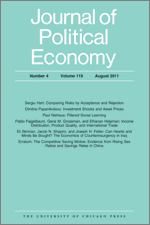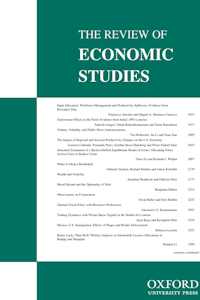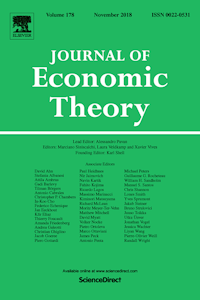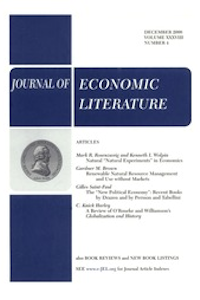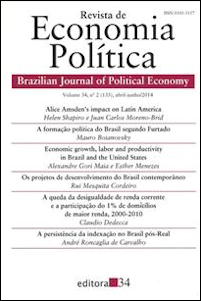
Palma, J. G.
How to create a financial crisisby trying to avoid one: the Brazilian 1999-financial collapse as "Macho-Monetarism" can't handle "Bubble Thy Neighbour" levels of inflows
Brazilian Journal of Political Economy
(2014)
Abstract: Brazil, as the rest of Latin America, has experienced three cycles of capital inflows since the collapse of the Bretton Woods system. The first two ended in financial crises, and at the time of writing the third one is still unfolding, although already showing considerable signs of distress. The first started with the aftermath of the oil-price increase that followed the 1973 ‘Yom Kippur’ war; consisted mostly of bank lending; and finished with Mexico’s 1982 default (and the 1980s ‘debt-crisis’). The second took place between the 1989 ‘Brady bonds’ agreement (which also marked the beginning of neo-liberal reforms in most of Latin America) and the Argentinian 2001 crisis. This second cycle saw a sharp increase in portfolio flows and a rise of FDI, and ended up with four major crises (as well as the 1997 one in East Asia) as newly-liberalised middle-income countries struggled to deal with the problems created by the absorption of those sudden surges of inflows — Mexico (1994), Brazil (1999), and two in Argentina (1995 and 2001). Finally, the third inflow-cycle began in 2003 as soon as international financial markets felt reassured by the surprisingly neoliberal orientation of President Lula’s government; this cycle intensified in 2004 with a (mostly speculative) commodity price-boom, and actually strengthened after a brief interlude following the 2008 global financial crash. The main aim of this paper is to analyse the Brazilian 1999-financial crises during the second inflow-cycle from the perspective of Keynesian/ Minskyian/ Kindlebergian financial economics. I will attempt to show that no matter how diversely the above mentioned countries tried to deal with the inflowabsorption problem — and they did follow different routes, none more unique than Brazil — they invariably ended up in a major financial crisis. As a result (and despite the insistence of mainstream analysis and different ‘generation’ models of financial crises), these crises took place mostly due to factors that were ‘intrinsic’ (‘endogenous’ or ‘inherent’) to middleincome countries that opened up their capital account indiscriminately to over-liquid and excessively ‘friendly-regulated’ international financial markets. As such, these crises were both fully deserved and fairly predictable. Therefore, I shall argue that the general mechanisms that led to Brazil’s 1999-financial crisis were in essence endogenous to the workings of an economy facing i) full financial liberalisation; ii) several surges of inflows, especially immediately after the Mexican 1994 and the East Asian 1997 crises — and as a spillover of the respective rescue packages —, following a new ‘bubble thy neighbour’ speculative-strategy by international financial markets, as ever more liquid, volatile, politically-reassured, and progressively unregulated financial markets were anxiously seeking (and allowed to create artificially) new high-yield investment opportunities via a new sequential speculative-strategy; and iii) ineffective domestic financial regulation — especially lack of effective capital controls. I shall also argue that within this general framework, the specificity of the Brazilian crisis was given by having been affected by i) several external shocks; ii) by a naïve ideology directing economic reform; iii) by a exuberant (post-‘second generation’ models)-style monetarism, or ‘macho-monetarism’, that although successful in achieving initially price-stabilisation, and in avoiding that Brazil became ‘another Mexico’ (in terms of keeping Brazil away from an inflow-led Kindlebergianmania), it did so at a growing (and mostly unnecessary) cost; iv) the creation of several major financial fragilities in the banking sector (private and public) and in State finances — leading the Federal Government to sleepwalk into a Minskyian ‘Ponzi-finance’; and v) by this ‘Ponzi’ being turbo-charged by both the Government’s indiscriminate absorption of nonperforming debt, and by it paying a huge amount (mostly in the form of subsidies) in order to get the constitutional reform that would allow the President to run for a second term.
Keywords: 'Endogenous' financial crisis, 'Second generation' models, Neo-liberal economic reforms, Ideology, Financial liberalisation, Capital controls, Systemic market failures, Latin America, East Asia, Keynes, Minsky and Kindleberger
JEL Codes: D70, D81, F21, F32, F40, G15, G28, G38, H12, L51, N20, O16, O43
Author links: Jose Gabriel Palma
Cambridge Working Paper in Economics Version of Paper: How to create a financial crisis by trying to avoid one: the Brazilian 1999-financial collapse as "Macho-Monetarism" can't handle "Bubble Thy Neighbour" levels of inflows, Palma, J. G., (2013)

